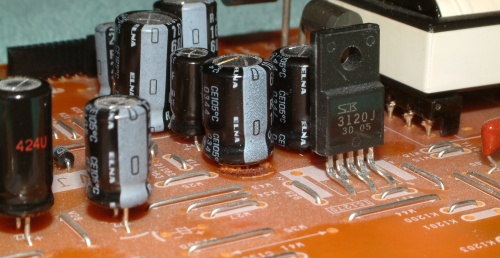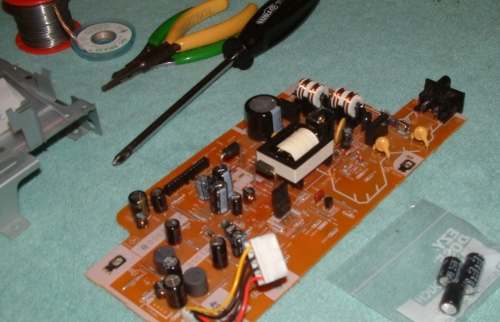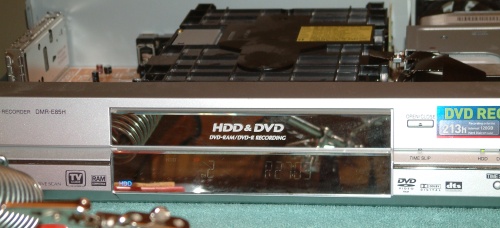My bike ride today involved swinging past the local Lumber and Builder Supplies and ordering some <izzard>PIECES OF WOOD!</izzard>.
In no time at all we will achieve workbench.
from the desk of Colin Nicholls
My bike ride today involved swinging past the local Lumber and Builder Supplies and ordering some <izzard>PIECES OF WOOD!</izzard>.
In no time at all we will achieve workbench.

The beans are doing incredibly well. I think we have enough to offer our neighbour, except he has plenty of his own.
Our little nectarine tree has produced 6 fruit this year, and two of them were ripe enough to be picked.
One cucumber from the scraggly plant, and a squash from the plant-that-was-supposed-to-be-an-Eggplant.
The Sweet 100’s tomato bush produced its usual daily handful, but the big news is from the other tomato plants. These are plants I grew from seed, from hierloom tomatoes we purchased last year from the market. The tomatoes were so delicious that I saved the seeds, grew seedlings this Spring and now the plants are producing.
The one on the left is from a variety I called “Tri-Tip” because the flesh is dark red and the internal structure is kind of undefined and you carve it into slices.
The one on the right is from a variety I called “Stripe”, for obvious reasons.
Mid-July already?
The absence of content here might have something to do with trying to get 45 minutes outdoors on the mountain bike each day, and also working on the next version of the prodigal sounds web site.
There were eight tomato seeds placed in this container three weeks ago.
And yet, I am delighted with the results so far:

The South-facing garage window gets quite a bit of sun during the day. Hopefully it will be enough to see this little guy through to potting stage.
Google Sketchup is pretty amazing, for a free program. You can build up 3D models of things using primitive shapes, putting them together, zooming around and rotating, and even dimensioning. It’s tricky to use, but there is some valuable tutorial videos that explain things one tool at a time.
Here’s the workbench I’m planning on building:

I’m sure the free version has limitations (I must try printing, for example) but so far, it’s awesome.
This post is dedicated to my Dad.
A couple of months ago, our Panasonic DMR-E85H digital video recorder died. It did this once before, several years ago, and we took it to an official Panasonic repair facility where they did something to it and charged us about 50% of the cost of the original purchase. We kind of agreed that next time it died, that would be it, and we’d have to find a replacement.
It turns out that “they” don’t make them any more. You can’t buy a new device that records TV shows to hard disk, without involving a subscription, either to the cable company (who want to give you a cable decoder+integrated hard disk recorder) or to Tivo / DirectTV / SatelliteTV company. Screw that. According to the manufacturers, “customers are not asking for such devices”. That’s bullshit. I simply don’t believe it. It’s my believe that there is a corporate conspiracy going on between the media networks and the hardware manufacturers… but that’s a different rant blog post.
After some research, we found that second-hand Panasonic and similar units are commanding quite extraordinary prices. The nearest thing we found was a refurbished Philips DVDR3576H, on overstock.com. At first glance, it has similar specs, although with some trade-offs:
Positive: The Philips has a built-in ATSC digital tuner. This means that, if we were located somewhere
with line-of-sight to a HDTV transmitter, we could attach an aerial to the recorder and record free-to-air HDTV programs. (This is not currently feasible for us, living in a valley in the North Bay, not without some experimentation, for another time.)
Negative: It does not have a way to tell the cable television decoder box to switch channels. The Panasonic had an IR-Blaster, but the Philips does not. This means that, although we can set up a recording schedule on the recorder, we must manually set the channel to record on the cablebox. This is not “set it and forget it” by any means. If we want to record two shows on different channels on the same night, I basically have to set an alarm to remind me to go point the remote at the cablebox and change to the appropriate channel.
Also – the operating system on the Philips device is HORRIBLE in comparison to the Panasonic, which itself was no great thing of beauty.
But this post isn’t about the Philips. It’s about the Panasonic DMR-E85H. You see, I didn’t want to break it down or recycle it. I wanted to fix it.
My first thought was, OK, it’s completely dead, therefore the power supply has perhaps burned out (they have a known issue with overheating). I opened it up, and a visual inspection revealed no obvious component failure. So I got out the trusty multimeter, powered up the unit and tested the voltage rails. They had voltage! Drat. Without the technical manual, or an oscilloscope, or more sophisticated equipment, I wasn’t going to get much further. I closed the unit up and packed it away and grumped for a week.
Then I found this thread on avforums.com. This is a long-running thread (from 2006) and, after reading it all the way through, I concluded that there were still some things I could try. The most obvious problem was a failing voltage regulator, but it could also be failing electrolytic capacitors. It was worth opening up the unit and removing the circuit board of the Power Supply Unit (PSU) and giving it a closer examination.
(I wish I could say that I would have done this regardless, but the truth is that the posts on the AVForum thread gave me the confidence and incentive to try it.)

I was half-way there already, because the PSU board is located underneath the hard drive – I had to mostly disassemble the unit just to check the voltage rails. Removing the board was an extra step: four additional screws and disconnect one ribbon cable.
Breaking out the magnifying glass and reviewing the board revealed an obvious problem: Swollen and leaking electrolytic capacitors, just behind the voltage regulator:

There were three of them that looked suspect. Now I had a plan: replace them! Using solder braid and my trusty soldering iron, I carefully removed the suspect devices.

I had some trouble obtaining replacements of similar size, but Electronics Plus in San Rafael had some that might fit. (Using over-spec’d voltage rating on caps is not a problem, providing they fit inside the chassis.)
After creatively arranging the larger capacitors on the circuit board and soldering them in place, I was ready to put it back together. Crossing my fingers and holding my breath, I powered it up:

It’s a little hard to see, but yeah, it worked. (does happy dance)
The Panasonic is now back in our living room equipment shelf under the television, recording shows and changing channels on the cable box via its IR-Blaster. The Philips will be relegated to our bedroom.

The trees are quiet; the birds have no-one to tease.
The Sun still streams into the den to tickle the rug; but no cat enjoys it today.
Yesterday, a long-time companion, worn-out, rested her head on her paw, in comfort at last.
“I’m never getting up again!” she said blissfully. And she was right.

So I was reading about all the remote-controlled "robot" predator drones flying around in Afghanistan and wherever, and it occurred to me that it would be a good story if an altruistic arms manufacturer started selling superior robotic war machines. Of course, eventually all the major powers would be fighting their battles "by wire", and after some years it would be revealed at the end of the story that all battles currently being fought were in fact being fought virtually with no actual presence in the real world.
Someone more talented than me has no doubt already written such a story.

The tomatoes grew in *our* garden. But the plate belonged to Grandma.
Where it's OK to say "We don't know the answer yet."
© 2025 Irregular Verbiage
Theme by Anders Noren — Up ↑
Recent Comments